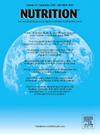Modulation of Δ5- and Δ6-desaturases in the brain-liver axis
IF 3.2
3区 医学
Q2 NUTRITION & DIETETICS
引用次数: 0
Abstract
Objective
Obesity is associated with liver depletion of ω-3 polyunsaturated fatty acids (ω-3 PUFAS) promoting steatosis and inflammation, whose levels are maintained by diet or biosynthesis involving Δ-5D, Δ-6D desaturases and elongases.
Method
We aimed to assess Δ-5D and Δ-6D activities in liver and brain from mice fed a control diet (CD) or high-fat diet (HFD) for four to sixteen weeks.
Results
HFD led to (1) an early (4 weeks) enhancement in liver Δ-5D, Δ-6D, and PPAR-α activities, without changes in oxidative stress, liver damage or fat accumulation; (2) a latter progressive loss in hepatic desaturation with insufficient compensatory increases in mRNA and protein expression, leading to ω-3 PUFA depletion, PPAR-α down-regulation reducing FA oxidation, and liver steatosis with enhancement in lipogenesis; and (3) brain ω-3 PUFA depletion after 12 to 16 weeks of HFD feeding.
Conclusion
In conclusion, the brain-liver axis is drastically affected by obesity in a time dependent fashion.

脑肝轴Δ5-和Δ6-desaturases的调节。
目的:肥胖与肝脏中ω-3多不饱和脂肪酸(ω-3 PUFAS)的消耗有关,ω-3 PUFAS可促进脂肪变性和炎症,其水平可通过饮食或涉及Δ-5D、Δ-6D去饱和酶和延长酶的生物合成来维持。方法:观察小鼠饲喂4 ~ 16周的对照饮食(CD)和高脂饮食(HFD)后肝脏和大脑中Δ-5D和Δ-6D的活性。结果:HFD导致(1)早期(4周)肝脏Δ-5D、Δ-6D和PPAR-α活性增强,氧化应激、肝损伤或脂肪积累未发生变化;(2)肝脏去饱和逐渐降低,mRNA和蛋白表达代偿性增加不足,导致ω-3 PUFA耗竭,PPAR-α下调,减少FA氧化,肝脏脂肪变性,脂肪生成增强;(3) HFD喂养12 ~ 16周后脑ω-3 PUFA耗竭。结论:肥胖对脑肝轴的影响具有明显的时间依赖性。
本文章由计算机程序翻译,如有差异,请以英文原文为准。
求助全文
约1分钟内获得全文
求助全文
来源期刊

Nutrition
医学-营养学
CiteScore
7.80
自引率
2.30%
发文量
300
审稿时长
60 days
期刊介绍:
Nutrition has an open access mirror journal Nutrition: X, sharing the same aims and scope, editorial team, submission system and rigorous peer review.
Founded by Michael M. Meguid in the early 1980''s, Nutrition presents advances in nutrition research and science, informs its readers on new and advancing technologies and data in clinical nutrition practice, encourages the application of outcomes research and meta-analyses to problems in patient-related nutrition; and seeks to help clarify and set the research, policy and practice agenda for nutrition science to enhance human well-being in the years ahead.
 求助内容:
求助内容: 应助结果提醒方式:
应助结果提醒方式:


